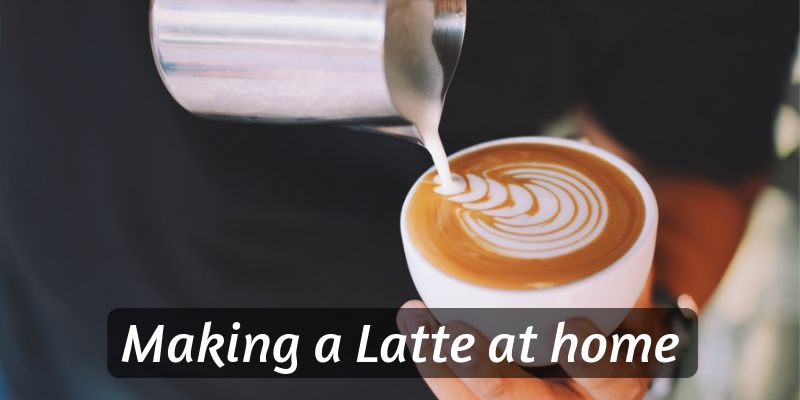Making your own latte at home is a very rewarding experience, and is probably a skill you'll have to learn to master for when guests come over. After all, if you can make a latte, you can also make a cappuccino or a macchiato, no ?
Let's begin with how to make a latte at home, since this is pretty much everyone's favorite.
Table of Contents
The anatomy of a latte
First, let's start by understanding how a latte is built. You have one layer of espresso - usually a double shot - and about 5-6 times as much milk, in one form or another.
This means steamed milk, microfoam, and frothed milk. These are all combined by your barista to get you that cup of latte, and they usually end up as a large drink, toppings included.
Now, when doing this at home you might not be able to build it as beautifully as a barista. Still, you can get pretty damn close, with a little care and some creativity.
You might think pouring the milk is the important part, or the hardest, but there are ways to make it simpler and easier, while still being delicious.
Please keep in mind that making the milk takes less than brewing the coffee, so after you've read this post, try and practice frothing the milk so you get everything right.
We're going to work with a 7-8 oz/200-236 ml drink, in terms of weight. Keep in mind that this is going to end up as a larger drink, since the milk will nearly double in volume, so you'll probably need a 16 oz/470 ml cup to keep it all in.
This translates into:
- 1 oz double shot espresso
- 6 oz milk, frothed and will double in volume
If this recipe turns out too large for you, feel free to cut everything in half and the total volume should be somewhere around 8 oz/236 ml, but will actually be something like 4 oz/118 ml by weight.
How to froth milk without a steam wand
So let's start with the milk, since we've been talking about it for so long. This is what you'll have to have on hand when you make your latte, since it requires the most concentration on your part.
I've made an entire post on how to steam and froth milk at home, which you can check for more than one method. But today, we're using the milk frother wand since it provides the best balance between frothed milk and microfoam.
As always, you will need warm, evenly heated milk. And you will also need to know how large your latte is going to be, or rather how big you'll want to make it since you're in charge of your drink here.
If you're following this recipe then you're going to end up with one Starbucks sized latte (about 16 oz/470 ml). So, this means you're going to need 6 oz/177 ml of warm (never hot or boiling) milk.
For warm milk you should aim for 68 C/155 F, since that seems to be the right temperature. You can use a cooking thermometer like this one from Amazon to help you out.
This is for a hot latte, so if you're going to an iced latte then you should keep the milk cold, and consider adding an ice cube or two to your final drink.
So fill your pitcher about ⅓ of the way with the 6 oz of warm milk. This means you're going to need a larger pitcher, just to be safe. If you put in too much milk, it might end up spilling over if you're not careful.
The milk will double in volume, and you're going to keep an eye on it.
Once your pitcher has milk in it, carefully insert the tip of the frothing wand into the milk. You'll hear it buzz and start to make bubbles into the milk. This is good.
Keeping the tip of the wand close to the bottom of the pitcher will result in mostly microfoam. Keeping it close to the top of the milk will result in thicker froth with large bubbles.
For latte you'll need mostly microfoam, and a bit of froth for the upper layer. So gently move your wand up and down the milk, but for the most part keep it near the bottom of the pitcher.
This will take some time, possibly a whole minute. By the end you should have just a bit of warm liquid at the bottom of the pitcher, a large layer of microfoam (or as close to it as possible), and some froth near the top.
If the ratio is a bit of, that's alright. After all, if this is your first time using such a wand then you're not expected to know everything.
If you have no milk frothing wand to speak of, then consider this one by Zulay. It's automated, runs on batteries, and has a pretty long wand to help you froth milk and even get close to microfoam.
You can check the listing on Amazon here, and read the reviews as well.
When the milk is done it will be a little uneven, and you might have some larger bubbles that have no place there. Gently swirl the milk around the pitcher, or tap its side to release the larger bubbles.
So once your milk is done, you can pour it into the espresso, or the other way around.
How to make latte without an espresso machine
Alright, now let's get to actually brewing that espresso for your latte. I'm going to assume you have no espresso machine, otherwise things would be easy.
If you do have an espresso machine, head on over to my basics on how to brew an espresso. Follow those steps and you should be able to brew a damn good shot for your latte.
Alright, back to those without a machine. We're using a double shot, which means this espresso will be strong, actually double the strength of a regular espresso.
Normally one shot is 1 oz/33 ml. But here we're going to use a double shot, which is still going to be 1 oz/33 ml but also going to be double the strength of a regular shot, since we're suing double the amount of coffee.
If you want your coffee even stronger, you can consider using a triple shot, and letting it run until it reaches 45 ml/1.5 oz.
And what does double the amount of coffee mean ? One shot has a minimum of 7 grams of ground coffee, and up to 9 grams. So, a double shot will be 14-18 grams of ground coffee. A triple would be 21-27, depending on how much you intend to use.
I recommend getting out your kitchen scale to measuring this out, if you're unsure. If you have no kitchen scale, this one from Amazon will do just fine.
I'm going to give you two options here, as how to best brew your mock espresso for the latte. It won't be the real thing, but it's gonna be close.
Use a Moka pot for a strong cup of coffee
A Moka pot can get you a strong cup of coffee that's going to be pretty close to an espresso. It's even going to look a lot like an espresso, crema and everything.
So, what you'll need for a Moka coffee is:
- Moka pot
- 40 ml/1.3 oz water, since some of it will be left with the coffee grounds
- 14-18 grams of ground coffee
Now, in the lower compartment of the Moka pot you're going to add your water. Some of it will be trapped by the ground coffee, so you need to put in a little more than what your final drink is supposed to be.
In the middle compartment you're going to add your ground coffee, and the filter plates, and screw everything together.
And the upper chamber is where everything is going to collect, and what you'll need to watch so you get the coffee right.
This is harder to do with a small amount of coffee, but still doable.
If you don't have a Moka pot, then maybe this one from Bialetti will do the trick. It can brew up to 4.4 oz/130 ml of coffee in one go, and is definitely going to get you that near-espresso coffee flavor.
Know that you can also find larger sizes on the vendor's page, but this is a size that would be great for making latte at home, and thus just brewing espresso and other small servings of coffee.
You can check the listing on Amazon here, and read the reviews as well.
Place your Moka pot on the stove, and turn the heat on. the heat will make the water withing the lower chamber boil and steam, and the pressure of that steam is going to push the hot water through the coffee grounds, very much like an espresso machine.
However this will be slower, and will take a few minutes for the water to reach that temperature. Once it's there though, it moves pretty fast, and you should see the upper chamber fill with brewed coffee, and hopefully some crema as well.
You won't see this very well at first, since you need to keep the lid on the upper chamber closed otherwise it might splatter coffee everywhere. But you'll definitely hear a change in sound when the coffee is done, and there is no more water left to come out.
When you hear that, turn the heat off and remove the pot from the stove.
Pour into the cup you plan you enjoy your late from, and you're done.
Use an Aeropress for almost espresso
Alright, what about the Aeropress ? That's going to give you a very similar cup of coffee to an espresso, very true. So let's use that option as well.
For an Aeropresso espresso you'll need:
- 14-18 grams ground coffee
- Aeropress
- hot water , 40 ml/1.3 oz heated at 90-93 C/194-200 F
- a hot cup to collect the coffee in
If you have no Aeropress the this one is going to help you out. It's the classic Aeropress we all know and love, and it can brew up to 3 cups of coffee for you.
Of course, for latte we're only going to need it to make us an espresso, but it's nice to have the option.
It's travel friendly, light weight, and comes with its own filters and everything.
You can check out the listing on Amazon here, and read the reviews as well.
First you'll need to screw the filter on the lower part of the Aeropress, and load the ground coffee into the tube. Gently but firmly tap the press on the counter to set the coffee at a mostly even level.
Make sure you put the coffee cup under the nozzle of the Aeropress before you brew, so it fills with espresso.
Then, add another paper filter on top of the ground coffee, and take your plunger to tamp the coffee. Do this by using a slight twisting motion, since you're going to need to pack it pretty tightly.
The reason we're doing this is because tightly packed coffee is going to simulate the coffee in an espresso portafilter. The tighter the coffee is packed, the harder water will go through it, and the better chance you'll have at achieving that layer of crema, as well as a flavor close to espresso.
So once your coffee is packed, add the hot water gently, in a circular motion. Once your water is in the press, put the plunger in, but at a slight angle.
Then very carefully pull it back a little, to create some sort of vacuum seal. This will help with brewing.
Then slowly but firmly push down on the plunger, much like you would for a French press.
You'll feel some pressure, since the plunger won't go down easily. And you're also going to notice a slight 'whoosh' sound at the end of the plunge. That's the air you've used as a vacuum seal exiting the Aeropress once the brewing is done.
And you're done, you should have a pretty convincing faux-espresso in your cup.
Mix the milk and coffee into a latte
Finally, once you've brewed your coffee one way or another, you can feel free to mix the coffee with the milk. Now, which way you do it is up to you.
Some swear by adding the espresso to the frothed milk, since it makes the drink creamier somehow, and also preserves the crema from the espresso. You also get a nice dark spot where you pour the espresso, which can look pretty nice.
Other still insist that adding the frothed milk to the espresso is the only way to go. At least, this is the way most baristas do it.
So, if you're adding espresso to milk, you'll need to transfer your milk into the cup you're drinking from. Then, once everything is done you can slowly add your espresso, in a thin stream. And that's pretty much it.
But, if you're adding milk to espresso, you will need to hold back the foam with a spoon while you add what's left of the liquid milk.
Then you can either slowly pour out the frothed milk and microfoam, or spoon it over your drink, whichever way you prefer. Though you can play with it a little and try to pour it artistically, in an attempt at latte art.
One word though, when you do pour your milk pour it at a angle. Hold you cup of espresso at a 45 degree angle, and slowly pour out the microfoam and frothed milk.
As the drink reaches its top, slowly bring it back to its normal position. Many baristas jiggle the cup a little to create lines while the milk flows, and towards the end move the stream across those lines, ending in a sort of leaf pattern.
Conclusion
With a little practice you can make your own lattes at home, maybe as good as you can get them in a coffee shop. Maybe even better, since you're the master of your latte now, and you can add in whatever you like.
I hope this guide was helpful to you, since making a latte at home without an espresso machine is, well, kinda hard. After all, this is a drink based on espresso and mixed with very well frothed and steamed milk, so you're going to have a slightly different end product by not using those items.
If you want to know more about coffee or tea, feel free to check the related articles below. Who knows what else you might find ?








